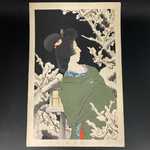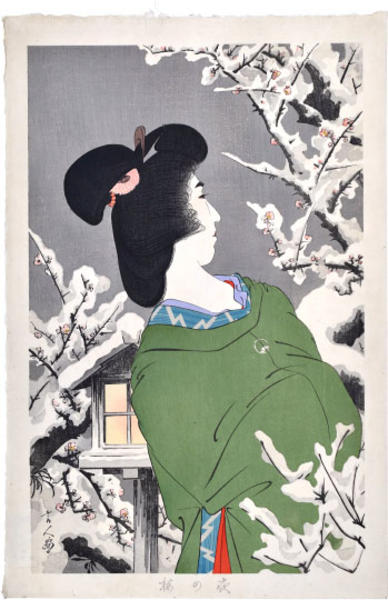| Notes (this edition)?: |
| The following information was taken from the original web listing of this artwork. Note that there may be some inaccuracies:
Torii Kotondo
1900-1976
Plum Blossoms at Night
(Yoru no ume)
signed within the composition at lower left, Kotondo ga, the title on the bottom margin, Yoru no ume, published by Ikeda Tomizo, 1934
dai oban tate-e 17 5/8 by 11 1/2 in., 44.8 by 29.3 cm
The publisher Ikeda Tomizo began producing an unititled set of twelve limited edition bijin prints by Kotondo in November 1931, completing the last two designs, including this one, in 1934. In spite of producing some of Kotondo's most important prints (including the iconic Morning Hair), there is little known about the Ikeda publishing house. This design is one of the more scarce Ikeda prints, and what few impressions that are published feature a completely black background. This unnumbered variant impression appears to be a test print of a subtle grey gradating background.
References:
Masao Takashima, Torii Kotondo, Gallery Beniya, Japan, 1995, p. 16, no. 7 (black variant)
Exhibition of Torii Kotondo, the 100th Anniversary of his Birth, The Works of Torii Kiyotada VIII, Ota Memorial Museum of Art, 2000, p. 48, no. 99 (black variant)
Reigle Newland, Amy, and Hamanaka Shinji, The Female Image: 20th Century Prints of Japanese Beauties, 2000, p. 139, no. 186-2
Andreas Marks, Seven Masters: 20th Century Japanese Woodblock Prints from the Wells Collection, pp. 188-189 (on Ikeda prints); and p. 263 (listed) |
|
| Artist Bio: |
| Torii Kotondo (or Torii Kiyotada VIII) is renowned for his paintings and shin hanga prints of beautiful women. His woodblock prints, superbly carved and printed, are comparable with those of Hashiguchi Goyo and Ito Shinsui. Kotondo was born with the name Saito Akira in the Nihonbashi district of Tokyo. He was the only son among the five children of Torii Kiyotada, the seventh Torii master. The Torii school had a long tradition of painting and printmaking for the Japanese theater, extending back to the seventeenth century. Kabuki theater was still very popular in the early twentieth century and prints and painted posters were the primary means of publicity. Although Kotondo was mainly interested in studying history and archaeology, it was assumed that he would follow in his father's footsteps and join the Torii school. At age 14, Kotondo agreed to leave school and begin studies with Kobori Tomone, a yamato-e painter. Along with painting classes, Tomone taught Kotondo about the court and military practices of ancient Japan, satisfying his interest in history. A year later, he was officially adopted as the next heir of the Torii school and assumed the artist's name 'Kotondo'. While still studying with Tomone, he began designing illustrations for a theatrical magazine, Engei Gaho ('Entertainment Illustrated Magazine'), and painted kabuki posters and billboards. Torii Kotondo was the 8th Torii and the 5th Torii Kiyotada. His father was the 4th Kiyotada.
|
|







